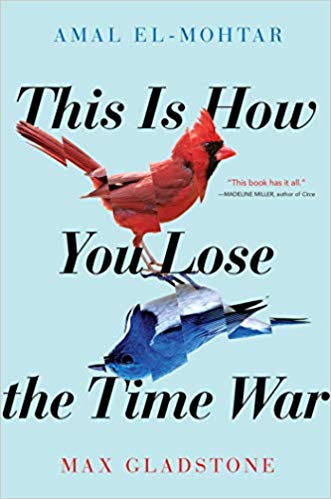When I think of Time Wars, I immediately think of Doctor Who – the only survivor of the war between Gallifrey and the Daleks, not to mention a long-running and beloved BBC series. But Amal El-Mohtar and Max Gladstone’s THIS IS HOW YOU LOSE THE TIME WAR has an entirely different take on what a time war might look like. It’s not an easy book to describe: Literary sci-fi? Epistolary espionage? Absolutely bonkers romantic thriller? Even now, I’m not quite sure how to categorize it, except as “What You Should Read Next.”

THIS IS HOW YOU LOSE THE TIME WAR is told (mostly) in letters sent between Red and Blue, two agents on opposing sides of the Time War. They’re top-notch secret agents/assassins/weapons, each one the best their side has. Red is part of The Agency, a hyper-connected, tech-heavy society. Blue belongs to Garden, an organic mass consciousness. The time war plays out across the universe, across eons, with Red and Blue tweaking the tiniest of events to eke out victories in battles eons later and entire worlds away. The two sides, like the Capulets and Montagues, have been feuding forever, battling for supremacy, and both Red and Blue are loyal soldiers.
Until they’re not.
Until the taunting letters they leave each other, scattered through time and space, become less about one-upping their counterpart and more about finding a kindred soul.
And then the fun begins. Not only do we watch Red and Blue find each other, but they find themselves. They begin to uncover what makes them individuals amid their massive regimes, and begin to imagine what their lives could be like outside the confines of a brutal, eternal war. Assuming, of course, they can survive.
I don’t want to tell you too much about the book —- part of its joy is piecing everything together, all the myriad clues and echoes and allusions woven throughout. Part of it is just the sheer delight of the crisp, vivid language, and the inventiveness of Red and Blue’s letters, hidden in tree rings and tea leaves and owl pellets. Part of it is the increasing tension, the sense of danger ramping up as these two characters grow ever more dear to each other. (Sure, they’re murderous super-soldier secret agents, but you can’t help hoping they’ll make it work.) And part is the elegance of the world-building, illustrating exactly how a time war works without making you sit through clunky exposition.
Instead of spoilers, I’ll simply say that THIS IS HOW YOU LOSE THE TIME WAR is not like any other book I have read in recent memory. It’s also one I intend to read again and again. Even if you’re not generally a fan of science fiction, even if you’ve never seen an episode of Doctor Who and wouldn’t know a Dalek from a Dalmatian, this brilliant, beautiful, surprising book is absolutely worth your time.

Categories: Books and More
